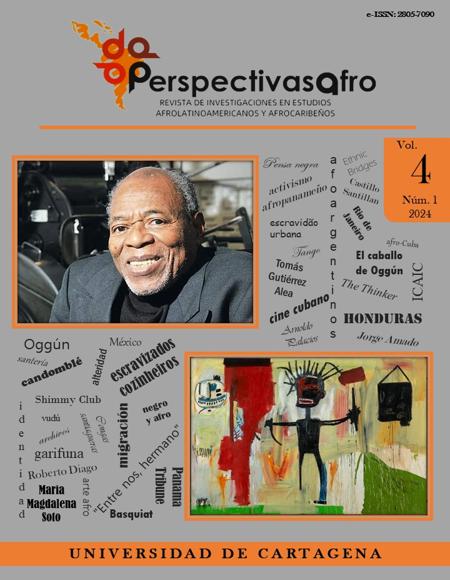Differential Experiences of Displacement in Transit through Mexico. The Ethnic Bridges among Garífuna and Honduran-Latino Groups
Experiencias diferenciales de desplazamiento en el tránsito por México. Los puentes étnicos entre los grupos garífuna y latinos-hondureños
Contenido principal del artículo
Resumen
This article focuses on the differential experiences of migratory displacement between two ethnic groups from Honduras; the Afro-American Garifuna and Latinos. It seeks to compare the differential migration strategies of these two ethnically distinct displaced populations from the same country. Both move towards the same destination starting with transit through Mexico and then attempting to reach the United States. The manuscript is based on fieldwork conducted in migrant shelters within the irregular migratory route in Mexico, also, in New Orleans and Houston, two major destinations for the Garifuna population in the U.S. The paper consequently focuses on the case of the Garifuna, for whom it identifies the processes of territorial exclusion in which they are involved from the origin, nevertheless put the Garifuna population at an advantage over their non-Garifuna countrymen Latinos concerning the migratory process and their migration networks, specifically for having a better previous integration in the country of destination.
Palabras clave
Descargas
Datos de publicación
Perfil evaluadores/as N/D
Declaraciones de autoría
Indexado en
- Sociedad académica
- Universidad de Cartagena
- Editorial
- Universidad de Cartagena
Detalles del artículo
Referencias (VER)
Agudelo, Carlos. “Los garífuna. Múltiples identidades de un pueblo afrodescendiente de América Central”. Revue Européenne des Migrations Internationales 27 (2013): 47-70.
Andrade-Eekhoff, Katherine y Silva, Claudía. “La globalización de la periferia: flujos transnacionales migratorios y el tejido socio-productivo local en América Central”. Revista Centroamericana de Ciencias Sociales 1/1 (2004): 57-86.
Bateman, B. Rebecca. “Africans and Indians: A Comparative Study of the Black Carib and Black Seminal”. Ethnohistory 37/1 (1990): 1-24.
Canales I. Alejandro y Rojas, Martha. Panorama de la migración internacional en México y Centroamérica. CELADE-CEPAL. 2018.
Chaney, James. “Malleable Identities: Placing the Garínagu (Garifuna) in New Orleans”. Journal of Latin American Geography 11 (2012): 121-144.
Duvell, Franck. “Transit Migrations in the European Migration Spaces Politics, Determinants And Dynamics”. Transit migration in Europe. Franck Duvell, Irina Molodikova y Michael Collyer, eds. IMISCOE. Amsterdam University Press, 2014.209-230
Duany, Jorge. “Reconstructing Racial Identity: Ethnicity, Color, and Class among Dominicans in the United States and Puerto Rico”. Latin American Perspectives 25 (1998): 147–172.
Amnistia Internacional. “El legado mortal de Guatemala: el pasado impune y las nuevas violaciones a los derechos humanos”. Visitado el 3 de enero del 2024, 2002, https://www.amnesty.org/es/documents/AMR34/001/2002/es/.
England, Sarah. Afro-Centroamericanos en Nueva York: relatos garífunas de movimientos transnacionales en espacios racializados. Peter Lang Publishing. 2019.
Fog Olwig, Karen. “Transnational Socio-Cultural System and Ethnographic Research: Views from an Extended Field Site”. Center for Migration Studies of New York 37/3 (2004): 787-811.
Garcia, Doris, John Watters, Rick Miller, and Perla M. Guerrero. “Social & Cultural Geography. Book Reviews”. Taylor & Francis 12/5 (2011): 509–515.
Gonzalez, L. Nancie. “From Black Carib to Garifuna: The Coming of Age of an Ethnic Group”. Actes du XLII Congres international Des Americanistes Vol. 6. 1979.
___. Sojourners of the Caribbean: Ethnogenesis and Ethnohistory of the Garifuna. University of Illinois Press. 1988.
Iborra, Juan Vicente. “Migración garífuna, deportaciones y asilo político en un contexto de desplazamiento forzado”. Andamios 45 (2021): 47-76.
Ivakhniouk, Ivan. “Analysis of the Economic, Social, Demographic And Political Basis of Transit Migration in Russia”. Migration Between Russia and European Union. Policy Implication from a Small-Scale Study of Irregular Migration. Lucy Williams y Serhan Aktoprak. Council of Europe IOM. 2004, 23-44.
Izard, Gabriel. Herencia y etnicidad entre los garífunas de Belice. Revista Mexicana del Caribe IX/17 (2004): 95-128.
López, Vladimir. “Desarrollo, migración y seguridad: el caso de la migración hondureña hacia los Estados Unidos”. Migración y desarrollo 21 (2013): 65-104.
Marconi, Giovanna. “Ciudades de tránsito, guardianes del primer mundo. – Entre desafíos, contradicciones y compromisos”. VI Encuentro Anual de RedGob. 2008.
Morales, Jorge. “Pensando en clave psicosocial y confesional. Testimonios dentro de los albergues de migrantes”. Migración y Desarrollo 30 (2018): 179-192.
Navarro-Lashayas, Miguel. “Estrategias y resistencias ante el despojo y el desplazamiento forzado de las comunidades garífunas en Honduras. El caso de la bahía de Trujillo”. Revista de Estudios Sociales 76 (2021): 58-74.
Papadopulou, Aspasia. “Exploring the Asylum-Migration Nexus: A Case Study of Transit Migrants in Europe”. Global Migration Perspectives 23, 2005.
Portes, Alejandro. Sociología económica de las migraciones internacionales. España: Anthropos. 2012.
Pries Ludger. “Transnational Societal Spaces: Which Units of Analysis, Reference and Measurement?” Rethinking Transnational. The Meso-Link of Organization. Ludger Pries. Routledge, 2008. 1-20.




